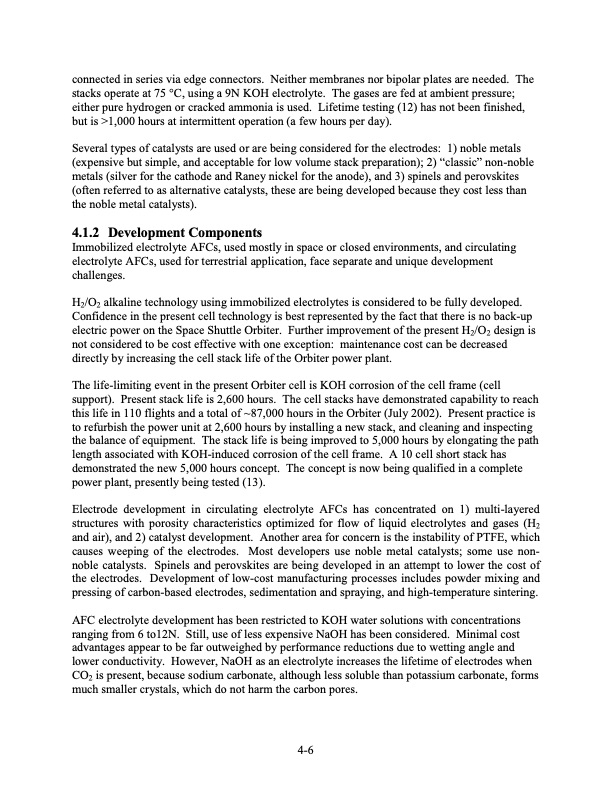
PDF Publication Title:
Text from PDF Page: 118
connected in series via edge connectors. Neither membranes nor bipolar plates are needed. The stacks operate at 75 °C, using a 9N KOH electrolyte. The gases are fed at ambient pressure; either pure hydrogen or cracked ammonia is used. Lifetime testing (12) has not been finished, but is >1,000 hours at intermittent operation (a few hours per day). Several types of catalysts are used or are being considered for the electrodes: 1) noble metals (expensive but simple, and acceptable for low volume stack preparation); 2) “classic” non-noble metals (silver for the cathode and Raney nickel for the anode), and 3) spinels and perovskites (often referred to as alternative catalysts, these are being developed because they cost less than the noble metal catalysts). 4.1.2 DevelopmentComponents Immobilized electrolyte AFCs, used mostly in space or closed environments, and circulating electrolyte AFCs, used for terrestrial application, face separate and unique development challenges. H2/O2 alkaline technology using immobilized electrolytes is considered to be fully developed. Confidence in the present cell technology is best represented by the fact that there is no back-up electric power on the Space Shuttle Orbiter. Further improvement of the present H2/O2 design is not considered to be cost effective with one exception: maintenance cost can be decreased directly by increasing the cell stack life of the Orbiter power plant. The life-limiting event in the present Orbiter cell is KOH corrosion of the cell frame (cell support). Present stack life is 2,600 hours. The cell stacks have demonstrated capability to reach this life in 110 flights and a total of ~87,000 hours in the Orbiter (July 2002). Present practice is to refurbish the power unit at 2,600 hours by installing a new stack, and cleaning and inspecting the balance of equipment. The stack life is being improved to 5,000 hours by elongating the path length associated with KOH-induced corrosion of the cell frame. A 10 cell short stack has demonstrated the new 5,000 hours concept. The concept is now being qualified in a complete power plant, presently being tested (13). Electrode development in circulating electrolyte AFCs has concentrated on 1) multi-layered structures with porosity characteristics optimized for flow of liquid electrolytes and gases (H2 and air), and 2) catalyst development. Another area for concern is the instability of PTFE, which causes weeping of the electrodes. Most developers use noble metal catalysts; some use non- noble catalysts. Spinels and perovskites are being developed in an attempt to lower the cost of the electrodes. Development of low-cost manufacturing processes includes powder mixing and pressing of carbon-based electrodes, sedimentation and spraying, and high-temperature sintering. AFC electrolyte development has been restricted to KOH water solutions with concentrations ranging from 6 to12N. Still, use of less expensive NaOH has been considered. Minimal cost advantages appear to be far outweighed by performance reductions due to wetting angle and lower conductivity. However, NaOH as an electrolyte increases the lifetime of electrodes when CO2 is present, because sodium carbonate, although less soluble than potassium carbonate, forms much smaller crystals, which do not harm the carbon pores. 4-6PDF Image | Fuel Cell Handbook (Seventh Edition)

PDF Search Title:
Fuel Cell Handbook (Seventh Edition)Original File Name Searched:
fuel-cell-handbook.pdfDIY PDF Search: Google It | Yahoo | Bing
NFT (Non Fungible Token): Buy our tech, design, development or system NFT and become part of our tech NFT network... More Info
IT XR Project Redstone NFT Available for Sale: NFT for high tech turbine design with one part 3D printed counter-rotating energy turbine. Be part of the future with this NFT. Can be bought and sold but only one design NFT exists. Royalties go to the developer (Infinity) to keep enhancing design and applications... More Info
Infinity Turbine IT XR Project Redstone Design: NFT for sale... NFT for high tech turbine design with one part 3D printed counter-rotating energy turbine. Includes all rights to this turbine design, including license for Fluid Handling Block I and II for the turbine assembly and housing. The NFT includes the blueprints (cad/cam), revenue streams, and all future development of the IT XR Project Redstone... More Info
Infinity Turbine ROT Radial Outflow Turbine 24 Design and Worldwide Rights: NFT for sale... NFT for the ROT 24 energy turbine. Be part of the future with this NFT. This design can be bought and sold but only one design NFT exists. You may manufacture the unit, or get the revenues from its sale from Infinity Turbine. Royalties go to the developer (Infinity) to keep enhancing design and applications... More Info
Infinity Supercritical CO2 10 Liter Extractor Design and Worldwide Rights: The Infinity Supercritical 10L CO2 extractor is for botanical oil extraction, which is rich in terpenes and can produce shelf ready full spectrum oil. With over 5 years of development, this industry leader mature extractor machine has been sold since 2015 and is part of many profitable businesses. The process can also be used for electrowinning, e-waste recycling, and lithium battery recycling, gold mining electronic wastes, precious metals. CO2 can also be used in a reverse fuel cell with nafion to make a gas-to-liquids fuel, such as methanol, ethanol and butanol or ethylene. Supercritical CO2 has also been used for treating nafion to make it more effective catalyst. This NFT is for the purchase of worldwide rights which includes the design. More Info
NFT (Non Fungible Token): Buy our tech, design, development or system NFT and become part of our tech NFT network... More Info
Infinity Turbine Products: Special for this month, any plans are $10,000 for complete Cad/Cam blueprints. License is for one build. Try before you buy a production license. May pay by Bitcoin or other Crypto. Products Page... More Info
| CONTACT TEL: 608-238-6001 Email: greg@infinityturbine.com | RSS | AMP |